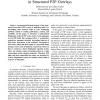Free Online Productivity Tools
i2Speak
i2Symbol
i2OCR
iTex2Img
iWeb2Print
iWeb2Shot
i2Type
iPdf2Split
iPdf2Merge
i2Bopomofo
i2Arabic
i2Style
i2Image
i2PDF
iLatex2Rtf
Sci2ools
77
Voted
SIGMETRICS
2008
ACM
2008
ACM
A Diophantine model of routes in structured P2P overlays
Abstract-- An important intrinsic property of any structured Peer-to-Peer (P2P) overlay is multi-hop paths. Understanding their structure helps to solve challenging problems related to routing performance, security, and scalability. In this paper, we introduce a mathematical Diophantine model of P2P routes. Such a route aggregates several P2P paths that messages follow. A commutative context-free grammar describes forwarding behavior of P2P nodes. Derivations in the grammar correspond to P2P routes. Initial and final strings of a derivation define message sources and destinations, respectively. Based on that we construct a linear Diophantine equation system, where any solution counts forwarding actions in a route representing certain integral properties. Therefore, P2P paths and their composition into routes are described by a linear Diophantine system; its solutions (basis) define a structure of P2P paths.
Related Content
| Added | 15 Dec 2010 |
| Updated | 15 Dec 2010 |
| Type | Journal |
| Year | 2008 |
| Where | SIGMETRICS |
| Authors | Dmitry Korzun, Andrei Gurtov |
Comments (0)

